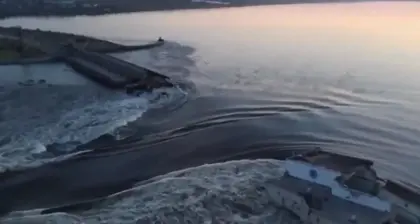Ukrainian officials on Tuesday said the Kremlin will be held to account for blowing up the Kakhkovka Dam on the Dnipro River, naming the specific Russian army unit allegedly responsible for installing the detonator charges and declaring the dam’s destruction a terrorist act and a war crime.
Oleksiy Danilov, an advisor to President Volodymyr Zelensky, said that Ukrainian military intelligence identified Russia’s 205th Motor Rifle Brigade as the unit most likely to have installed explosives inside the dam of the Kakhovka Hydroelectric Power Plant on the Dnipro River.
- Read the most current war in ukraine update from the Kyiv Post's daily news updates today.
- Obtain the most recent updates on the Ukraine situation today.
JOIN US ON TELEGRAM
Follow our coverage of the war on the @Kyivpost_official.
Members of the 205th, and possibly other Russian Federation civilian officials and military personnel, will, if found individually responsible for complicity in taking down the dam, be prosecuted for war crimes, Danilov said.
Explosives placed inside the Kakhovka Dam released a flood of water meters high on tens of thousands of unsuspecting civilians living downstream; and the Russian attack fully meets the definition of terrorism, use of a weapon of mass destruction, and constitutes a war crime, Danilov said, speaking at a Tuesday morning news show.
Andriy Yusov, an Armed Forces of Ukraine (AFU) military intelligence spokesman, told Kyiv Post Ukraine’s spy services had been tracking Russian activity at the dam and power station for more than a year, and that the Ukrainian government is sure Russian officials gave the order for explosive charges inside the station’s interior machine spaces to be set off.

Zelensky Meets CIA Director William Burns in Ukraine
The Kremlin’s intent in destroying one of the world’s largest hydroelectric stations was partly grounded in fears of Ukraine’s impending offensive, and partly, in the long-running Russian strategy of waging war against Ukraine by attacking Ukrainian civilians and civilian infrastructure, he said.
“Last year, Ukrainian military intelligence reported that the Kakhovka hydroelectric power station had been mined by Russian troops, publishing photo, and video evidence. Today, by committing this terrorist act, and genocide, the Russians are trying to complicate the de-occupation (liberation) of Ukrainian territories.
"In particular, there are fears of an amphibious landing. This terrorist act also continues Russia's nuclear blackmail policy, as it will complicate the security situation at Zaporizhzhia Nuclear Power Station,” Yusov said.
Engineers from 205th Brigade likely first installed explosives at the station in April 2022 and upgraded plans and materials almost continuously since then, Danilov said.
Natalia Humeniuk, spokeswoman for Ukraine’s Joint Forces South command, in comments to the UNIAN news agency and Radio Liberty said that “there is no question” the dam was demolished by an internal blast or blasts and pointed to widely-available video and still images in the public domain seeming to show the dam’s main structure collapsed from the inside.
The Russian national leadership ordered the structure destroyed in an attempt to hit because of frayed nerves, she said at a Tuesday morning press briefing.
“The Russians blew up a part of the structure (of the station) and are playing another blackmail card, to try and put pressure on (Ukrainian) defense forces, pressure on Ukraine as a whole. Having no more strength to wait where the counteroffensive will come from, they are trying to control the situation,” Humeniuk said.
“Probably, the Russian goal was to increase the volume of water on the surface (of the Dnipro), to keep Ukrainian forces from crossing quickly.”
Extensive images showing the dam heavily damaged at or below the waterline are near-conclusive evidence Russia, not Ukraine, knocked the structure down, she said.
Russian forces have controlled the Kakhovka power station and the dam, and the road bridge on top of it, since mid-March 2022. Advancing Ukrainian troops first reached the Dnipro River right near the dam in early November 2022. Exchanges of artillery and mortar fire back and forth across the river have been almost continuous, but intermittent, since then.
Some pro-Russia information platforms denied Russian responsibility. Readovka, a military information site according to many accounts operated out of Russia-occupied Donetsk, accused Kyiv of firing 300mm Ol’kha unguided rockets at the dam in a series of long-range strikes. The Moscow-installed mayor of Nova Kakhovka, Vladimir Leontiev, likewise, in a Monday statement claimed Ukrainian artillery blew up the dam.
Some Kremlin-aligned channels offered a contradictory message, not only identifying Russia’s top military command as the authority that ordered the dam blow-up, but even praising it.
Russian military serviceman Yegor Guzenko, reportedly blogging from the Kherson sector, said in Monday Telegram comments: “I told you we would blow up the dam… some of you said it wouldn’t happen… but now you see. From the tactical point of view, this means that a route across the Dnipro River is closed to the Ukrainian army.”
Images of the dam following its destruction lacked craters, smoke charring and surface damage typical in most heavy rocket strikes, Kyiv Post analysis of those images concluded.
Independent Ukrainian media, practically without exception, dismissed scattered Russian claims of an AFU strike on the dam. Typical was a UNIAN news agency report, pulled from Dec. 2022 archives, showing video of a Russian serviceman bragging about placing explosive charges inside the Kakhovka station.
Other evidence of probable Russian responsibility included posts pulled from 205th Brigade’s social media accounts seeming to show the unit specifically preparing to blow up the station.
You can also highlight the text and press Ctrl + Enter









